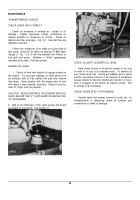TM-5-3805-254-14-P-1 - Page 45 of 590
OPERATION
OPERATOR'S DAILY REPORT
MAKE A DAILY REPORT OF ENGINE OPERATION TO
THE MAINTENANCE DEPARTMENT
The engine must be maintained in top mechanical
condition if the operator is to get optimum satisfaction
from its use.
Engine adjustments, etc., are the work of the
Maintenance Department.
However, the Maintenance
Department needs daily running reports from the
operator to make necessary adjustments in the time
allotted between runs and to make provisions for more
extensive maintenance work as the reports indicate the
necessity.
Comparison and intelligent interpretation of the daily
report along with a practical follow-up action will
eliminate practically all road failures and emergency
repairs.
Report to the Maintenance Department any of the
following conditions:
1.
Low lubricating oil pressure.
2.
Low power.
3.
Abnormal water or oil temperature.
4.
Unusual engine noise.
5.
Excessive smoke.
6.
Excessive use of coolant, fuel or lubricating oil.
7.
Any fuel, coolant or lubricating oil leaks.
MAINTENANCE
ENGINE MAINTENANCE SCHEDULE
Preventive maintenance performed on schedule is
the easiest, as well as the least expensive type of
maintenance.
It permits the Maintenance Department to
do work on schedule, rather than at inconvenient hours.
Accessories must have a place in the maintenance
schedule the same as the basic engine, for an accessory
failure may put the entire engine out of operation.
Consult accessory manufacturer for maintenance
recommendations.
A GOOD MAINTENANCE SCHEDULE DEPENDS ON
ENGINE APPLICATION
Actual operating environment of the engine must
govern the establishment of the maintenance schedule.
Some engines operate under rather clean conditions,
some under moderately dusty conditions and others
under severely dusty or dirty conditions; each type of
operation must be analyzed as the maintenance
schedule is established.
Hours of operation, miles (kilometers), or calendar
period as shown on Page 2-2 are convenient units of
measurement, and should be used to set up the
maintenance schedule interval basis.
These periods, as
stated, are based on average operating conditions.
EXTENDING THE MAINTENANCE SCHEDULE
Any change in the established maintenance
schedule should be preceded by a complete reanalysis
of the operation.
A lubricating oil analysis should be the
major
factor
used
in
establishing
the
original
maintenance schedule; it should be studied before
making any change in or extending the schedule
periods.
In extremely dirty and under severe operating
conditions, the scheduled maintenance period may even
need reducing.
Again the operation should be re-
analyzed and a lubricating oil analysis should be made.
Extending or reducing the schedule period should be
done only after a complete study; basically, it should be
the same as used in establishing the original
maintenance schedule period.
USING THE SUGGESTED SCHEDULE CHECK SHEET
The maintenance schedule check sheet is designed
as a guide until adequate experience is obtained to
establish a schedule to meet a specific operation.
A detailed list of component checks is provided
through several check periods; also a suggested
schedule basis is given for hours of operation, calendar
of time or miles (kilometers) driven.
A maintenance schedule should be established
using the check sheet as a guide; the result will be a
maintenance program to fit a specific operation.
The check sheet shown can be reproduced by any
printer so the forms may be available for use.
The
person making each check can then indicate directly on
the sheet that the operation has been completed.
When
a complete column (under A, B, C, etc.) of checks is
indicated, the engine will be ready for additional service
until the next check is due.
STORAGE FOR ENGINES OUT OF SERVICE
If an engine remains out of service for three or four
weeks (maximum six months) and
39
Back to Top




















